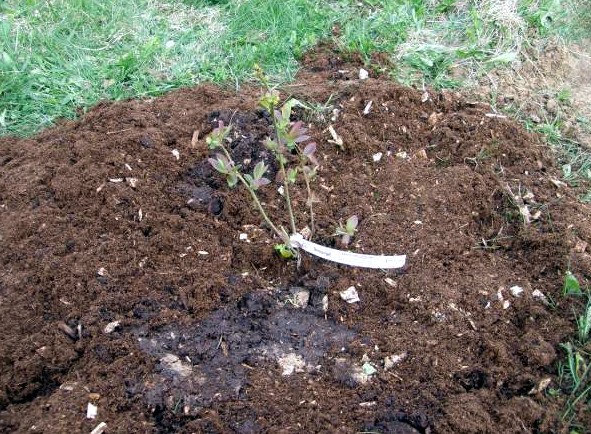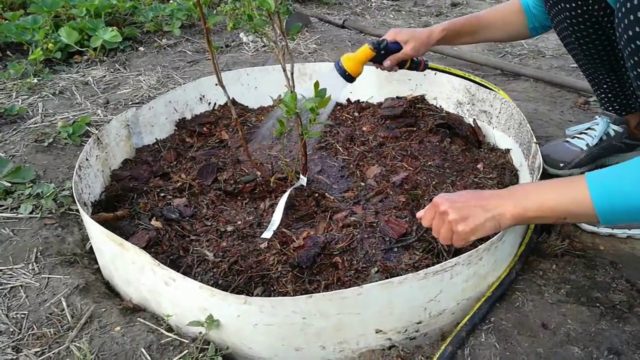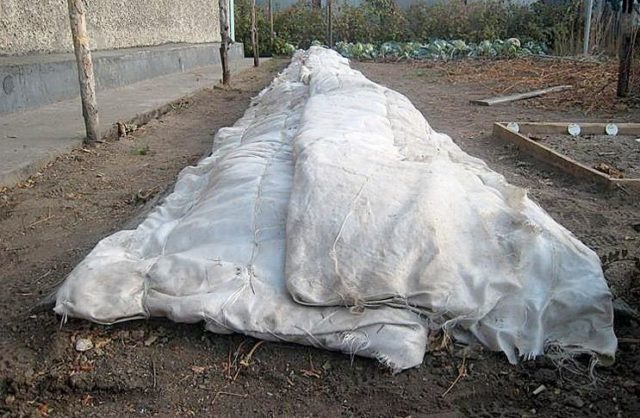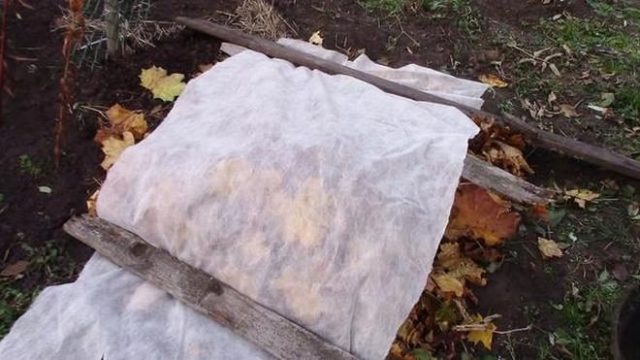Content
Small dark purple garden blueberries are good for vitamin C and are rich in natural vitamins and antioxidants. Growing blueberries in a garden or summer cottage has features associated with the characteristic features of the culture. Caring for blueberries in the fall is important for continued growth and a stable harvest.
When to plant garden blueberries: spring or fall
Wild blueberry bushes grow mainly in areas where the temperate cold climate prevails. In garden plots, it is grown as single bushes or whole plantations, if the size allows. With proper planting and observance of the rules of care, the bushes begin to bear fruit stably in the 2nd - 3rd year of existence.
The timing of planting blueberry seedlings depends on the characteristic features of the shrub culture. The trunk of the tree stretches up to 1.2 m, the fibrous root system does not have hairs that help trees and shrubs receive nutrition from the soil, so the formation of the aboveground part of the plant is slow.
In order for the bush to take root and take root, garden blueberries can be planted on the site in the fall or spring. The time for planting is chosen taking into account that the tree adapts before the onset of frost. In spring, blueberries are planted only before buds swell on the branches. Many gardeners believe that planting garden blueberries in autumn is preferable to spring because they do not have to take care of the bushes during the spring-summer period, when insects are common on the site, which interfere with the adaptation of bushes and contribute to the transfer of diseases.
How to plant blueberries in autumn
Planting blueberries in the fall is associated with the subsequent pre-winter preparation. This means that it is necessary to correctly calculate the period so that there is enough time for preparation and adaptation. In the fall, blueberry seedlings are planted, which are grown from an adult bush during the winter, or seedlings that are in flowerpots.
Recommended timing
For planting garden blueberries in the fall, warm days are chosen throughout the second half of September - the first half of October. The timing depends on the climatic characteristics of the region. Before the onset of subzero temperatures, there should be about 30 days. This period will be enough for the rooting and adaptation of the culture.
Site selection and soil preparation
Blueberries grow in garden plots where the bushes get enough sunlight. In addition, when choosing a site, the following rules are observed:
- exclude places with through winds;
- choose flat territories;
- avoid places with a high occurrence of groundwater so that the root system of the plant is not in constant moisture;
- take into account that there are no plantings of tall fruit and berry trees next to blueberries, which can shade berry bushes with their crowns.
Acidic soils are suitable for planting blueberries. Soil acidity indicators should be within the range from 3.5 to 4.5 ph. Loose and light soils are suitable for blueberries, this allows moisture to be absorbed faster and contributes to the active development of a fibrous root system.
The preparation of the soil for blueberries depends on the original composition.
Soil type | Training |
Light loam with groundwater deposition at a depth of about 2 m | They dig planting holes 60 cm wide and 40 cm deep. |
Heavy clay soil | A 10-centimeter hole is dug, covered with sand, peat and sawdust, the seedling is planted on the formed mound so that the root system is buried to the ground level. The bush is mulched with a high layer of sawdust. |
Sand and peat | A hole is dug 1 m wide, 50 cm deep, covered with a layer of a nutritious acidic mixture (peat, sawdust, needles, sand), then a seedling is placed, covered with the remaining soil. |
To increase the acidity of the soil in any area, acidification methods are used independently. For this, additives of dry powder of sulfur or a solution of oxalic or citric acids are used.
Selection and preparation of seedlings
Planting material for planting in the fall is purchased in specialized nurseries. The best option is considered to be 2 - 3-year-old bushes. At the same time, berry varieties are chosen that take into account the characteristics of the climatic zone. For Siberia and the Urals, varieties are chosen that are able to withstand low temperatures. The branches of the seedlings must be strong and healthy, free from damage and stains.
Container seedlings cover the roots from inspection, so they are specially prepared when planting. The container is spilled several hours before planting, then a clod of earth is carefully pulled out. The root system of blueberries during development can bend inward due to the flexibility of the roots. When planting, the roots are straightened so that they are directed downward and freely positioned along the planting hole.
How to properly plant blueberries in the fall
Planting blueberries in autumn is followed by special care related to the season, as well as preparation for winter. The speed of adaptation depends on whether the landing was done correctly.
For a medium-sized seedling, dig a hole 50 by 50 cm in size.On garden lands that are subject to active acidification, a special planting method is chosen using a 200-liter plastic barrel. It is laid at the bottom of the planting pit, covered with a layer of drainage. It can take from 10 to 20 cm. Then a small layer of the nutrient mixture is poured.
The seedling is placed in the center of the planting hole, filled with prepared nutrient mixture and tamped. About 1.5 m is left between the bushes, the roots most often grow in breadth, so they need a lot of space. The distance between the rows is extended to 2 m.
After watering the bushes, the berries are recommended to mulch the soil around. For mulch, acidic materials are chosen: sour peat, coniferous bark, rotted coniferous sawdust. Mulch protects the soil from freezing, moisture loss and prevents weeds from spreading.
How to care for blueberries in the fall
When planting berries in the fall, caring for bushes before winter takes less time than spring and summer care. During this period, it is necessary to take care of the correct watering and feeding of the plant.
The top layer of the soil during the adaptation period should be moderately moist. The amount of moisture consumed directly depends on the autumn weather. On rainy and cloudy days, additional watering of the soil should not be done, so as not to overmoisten the roots.
Dry weather requires weekly watering, about 10 liters of water for each bush planted.
In autumn, potassium sulfate or potassium nitrate is added to the soil. Liquid solutions are not suitable for fertilization. The complexes are applied with dry granules and dug up with soil. In autumn, it is not advised to fertilize blueberries with nitrogen-containing mixtures, they are suitable for spring feeding.
In addition, an important agricultural technique when caring for blueberries in the fall is the complete pruning of the planted bushes:
- weak and damaged branches are cut out completely;
- cut strong and healthy branches in half.
How to hide blueberries for the winter
In winter, blueberries are protected from freezing. Hybrid varieties that are made for sub-zero temperatures are also covered to avoid loss of garden blueberry bushes.
Preparation for winter begins in the fall after disembarkation and includes several successive stages:
- Watering. Pre-winter watering of blueberries is abundant. It activates the spring budding. Abundant autumn watering is the entire amount of moisture that will feed the shrub in winter.
- Mulch. If, after planting, the soil was not mulched, then this must be done in preparation for winter. Mulch fulfills the duty of keeping heat and moisture for the soil. Given the peculiarity of the development of the blueberry root system, mulch also helps to keep the roots from freezing.
- Soil acidification. If, after planting, there is a suspicion of a decrease in soil acidity, then it is additionally acidified in warm autumn. With the onset of rainy and cold early autumn, acidification is shifted to the spring.
- Pruning. The blueberry bush is pruned in the fall without regrets. In spring, thawed branches will begin to grow actively, and in winter they will not be able to freeze with correct and timely pruning.
For winter shelter, burlap or agrofibre is used. The material of the additional shelter should be dense, but air-permeable, so that rotting does not begin inside the shelter.
The cut bushes are wrapped in material, tied with nylon threads and secured with additional oppression.
Adult bushes begin to bend to the ground in advance so that the branches bend well and do not break after strapping. When the branches lie freely on the soil, they are covered, tied up and additional holders are laid. Small heavy boards, bricks are suitable for this.
When snow falls, collected snowdrifts are additionally applied to the covered bushes. They will become a natural protective layer against freezing. On this, caring for blueberries in winter can be considered over.
In the spring, snow is removed before it melts. Then they begin to remove additional shelters so that the bush does not become covered with condensation at freezing temperatures.
What mistakes gardeners often make when hiding blueberries for winter
Beginners and experienced gardeners are not immune to common mistakes when growing a berry crop. Many people wonder when it is better to plant blueberries: in spring or autumn, what to do when planting in autumn, whether the bush will have time to adapt before frost. A mistake is the statement of novice gardeners: "If we plant blueberries in the fall, then they do not require any maintenance." This is a common misconception.
Typical mistakes that can be encountered on the path of growing blueberries:
- Excess moisture. Abundant pre-winter watering should not bring the soil to a swampy state. If the water does not have time to absorb before the temperature drops, then in winter the blueberry bush will freeze.
- Excess acid. With autumn acidification of the soil, an increased acid content leads to an increase in soil acidity. This negatively affects wintering and harms the further development of the bush.
- Loosening. Pre-winter loosening should not be deeper than 3 cm. Deeper digging of the soil can harm the root system, which is located close to the surface of the crop.
Conclusion
Caring for blueberries in autumn is a complex of agrotechnical techniques. Their further adaptation depends on how the autumn planting of seedlings went. Shelter for the winter and pre-winter care for mature shrubs helps to preserve shrubs without loss and prepare them for spring budding.
















